Galungan Ceremony
by Dayu
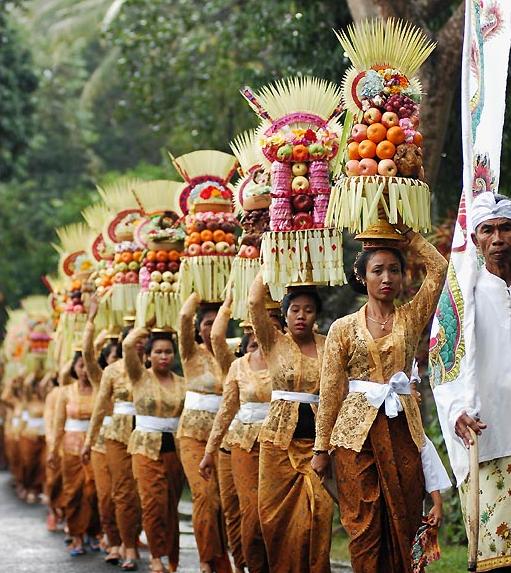
Bali Culture: Galungan ceremony
The word Galungan in ancient Javanese means victory, and the meaning of Galungan is to celebrate the victory of dharma (goodnes) againts adharma (crime/bad things) and to deliver gratitude to Ida Sang Hyang Widhi Wasa (main God) for creating the world and everything in it as well as the gifts that have been bestowed upon him.
The series of Galungan.
2. Sugian ceremony (Sugian Jawa and Sugian Bali)
The meaning of this ceremony is a process of self purification (Mikrocosmos) and also nature (Makrocosmos) because both are related to one another like a fetus in the womb. (if there is virtue in the heart, there will be beauty in the character. If there is beauty in the character, there will be harmony in the household. If there is harmony in the home, there will be order in the country. Finally if there is order in the State then there will be peace in the world.) so everything has to start from yourself. First to be, second to do, third to tell.
3. Penyajaan
Penyajaan actually has the meaning of “serious” or sincerity in welcoming Galungan,penyajaan is held on Monday ( Soma Pon Dungulan, on Balinese calendar)or two days before Galungan, but some Hindus also interpret this feast as early preparation to make offerings, such as making cakes and so on.
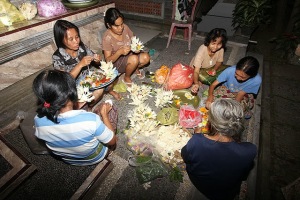
4. Penampahan
Then on Tuesday Wage wuku Dungulan, people do Penampahan. The word Penampahan is derived from the word “Tampah” which means kill. So penampahan means killing.The symbolic meaning is the sacrifice, for example is pigs, chicken or duck killed for religious ceremonies, unwilling to Ida Sang Hyang Widhi Wasa for yadnya purposes, slaughter pigs also contains a symbolic meaning to kill all the animalistic lust in man.The Balinese public in general, on the day of Penampahan ancestors descendants will come to relatives in the world, because of that society also make special treats consisting of rice, side dishes, snacks, fruit, coffee, water, lekesan (betel leaf and nut) or cigarettes are presented to the ancestors who “stop by” them in their homes. At this time also the Balinese man will start to make Penjor, penjor is a symbol of respect to Mount Agung, Penjor itself has meaning expression of gratitude for the prosperity and well-being that bestows the bulk of Hyang Widhi wasa (God Almighty). Penjor is towering bamboo piece which curves like a picture of the sacred Mount Agung where the gods dwell. Penjors are made not only as a decoration. Because at the Penjor people will hang agricultural products such as rice, corn, coconut, and other snacks, as well as items of clothing (piece of cloth) and money. It has a meaning: the heart of the reminder, as the momentum to awaken a sense of the man, that all essential for life is a gift from Sang Hyang Widhi. All we use is grace, which is diligated to us, all because of His love. We rejoice receive the grace, either in the form of materials needed for life, as well as the devolved form of the power of faith and inner purity.
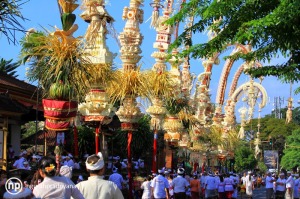
5. Galungan ceremony
Philosophy and Mythology
A brief history of Galungan.
Based Lontar Dvipa Purana Bali, Galungan was first celebrated in Bali at the time of Purnama Kapat, Buda Pon Dungulan, Çaka year 804. In this ejection mentioned “Punang aci Galungan ika ngawit Bu, Ka, Dungulan sasih kacatur, tanggal 15 isaka 804, Bangun Indria Buwana ikang Balirajya” means: Celebration (Ceremony) Galungan that began on Wednesday Pon (wuku) Dungulan, sasih Kapat (based on Balinese calendar), 15th Çaka 804 years or 882 years AD state of the island at the time likened to the residence of the god Indra. Since then Galungan has been celebrated regularly for approximately three centuries. But in the year 1103 Caka (1181M) during the reign of King Sri Ekajaya, the celebration of Galungan was eliminated for 23 years, or until the reign of King Sri Dhanadi. During that time, continuous disaster struck the island of Bali and the age of the officials said to be relatively short. To uncover the veil, Sri Jaya Kesunu, who ascended the throne to replace Sri Dhanadi, held a “Dewasraya” as an attempt to create better fortunes for the people and the island at Pura Dalem Puri Besakih.The king recieved a whisper from Ida Bethari Durga ( wife of God Siwa) at Besakih, saying that the disaster that struck the island and community were happening due to the halting of celebrating Galungan. Since the king got this whisper he eventually returned to celebrating Galungan in Bali as it is now.
To date no one has been able to confirm when Galungan was celebrated for the first time in Bali.
In the morning people start the ceremony for Galungan. Starting from praying in their homes up to the temple around the neighborhood. A Tradition is often encountered on Galungan is the Tradition of “Going Home” or pulangkampung inindonesian, the people who live in other areas than where their family reside ,will commute home for the celebration of Galungan.
For people who have family members who are still [Makingsan di Gumi] (which means buried and yet cremated), then the people are obliged to bring offerings to the grave with the term Mamunjung ka Setra, to the grave during Galungan.
5. Umanis Galungan
In Umanis Galungan, people will perform praiers at several temples and worship followed by Dharma Santi as well as visiting relatives or going recreational areas.
Where in Bali
Galungan is celebrated by all Hindus either in Bali or outside Bali. Usually for people who are outside of Bali, will perform the ceremony by performing prayers in temples closest to their area.
When is the ceremony
Galungan is celebrated by Hindus Bali every 6 months (210 days) on the day of Budha Kliwon Dungulan (Rabu Kliwon wuku Dungulan) based on Balinese calendar. And this year will be celebrated on Wednesday 17 December, 2014.

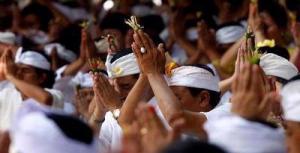
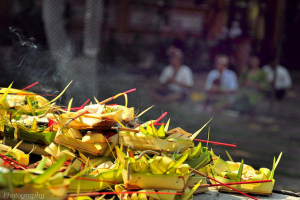
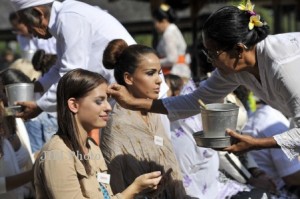








Leave a Reply